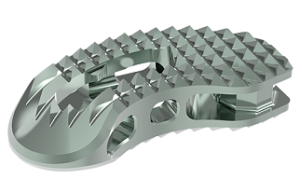The T-PAL Spacer System is a “kidney bean” style implant for use in TLIF surgery, which employs several ease of use features. The implant has pyramidal teeth as well as rails on the surface and a self-distracting bullet nose to facilitate a guided insertion technique. The spacers are offered in two footprints, 11 heights and a lordotic angle of 5° (0° for 7mm height spacers). The unique features include TRACK TECHNOLOGY™ and an articulating inserter which allows for better placement of the spacer through an open or MIS approach.
The T-PAL Spacer applicator features one instrument for the insertion of the spacer and trials. The applicator features a pivoting option for controlled insertion as well as rigid 0° and 80° positioning of the spacer.The T-PAL Spacer and applicator work in conjunction to allow a Guided Insertion Technique. Trial Spacers can be placed at the final spacer location.
Features:
- TRACK TECHNOLOGY™ : Guide and turn the spacer into position offering ease of use
- T-PAL™ Spacer applicator: Ease of use. One instrument designed for minimally invasive surgery for the spacer and trials offers a simple OR technique. Pivoting and Rigid options allow for controlled insertion facilitated by rails with a secure attachment of the spacer to the applicator for ease of use.
- Self-distracting bullet nose: Facilitates insertion and allows insertion into tight disc spaces
- Pyramidal teeth: Provide resistance to spacer migration
- Connection cylinder: Permits pivoting action of the applicator to reduce complications during insertion
- Materials:Titanium Alloy
- Axial window:Accommodates autogenous bone graft to allow fusion to occur through the spacer
- 5° Lordotic angle: Accommodates the natural spine lordotic curve (7mm height is 0°)
About TLIF
A transforaminal lumbar interbody fusion (TLIF) is performed to remove a portion of a disc that is the source of back or leg pain. Bone graft is used to fuse the spinal vertebrae after the disc is removed. TLIF provides fusion of the front and back of the lumbar spine. The front portion of the spine, called the anterior column, is stabilized by the interbody spacer and bone graft. The back portion, or posterior column, is locked in place with pedicle screws, rods and additional bone graft, alongside the backs of the vertebra.
Founded 1895 in Warsaw, Indiana, by Revra DePuy, DePuy operates as a brand under the Johnson &Johnson Medical organization.On April 27, 2011,DePuy and Synthes agreed to a merger deal. The DePuy Synthes Companies offer the world’s most comprehensive portfolio of orthopaedic and neuro products and services for joint reconstruction, trauma, spine, sports medicine, neuro, cranio-maxillofacial, power tools and biomaterials. http://www.depuysynthes.com


